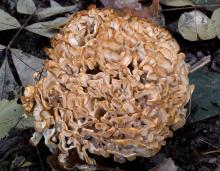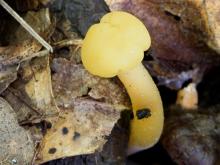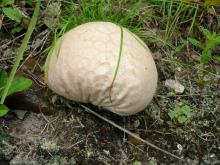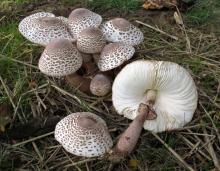Mushrooms
Media

Species Types
Scientific Name
Lenzites betulina
Description
Multicolor gill polypore is a bracket fungus with a semicircular, tough, hairy, multicolored, zoned cap; beneath, it's white, with leathery, gill-like tubes. It grows on dead deciduous wood.
Media

Species Types
Scientific Name
Meripilus sumstinei (formerly M. giganteus)
Description
The black-staining polypore grows in large, circular clusters of many fleshy, grayish yellow, fan-shaped caps, which bruise black when cut or touched. It grows on the ground around deciduous trees, especially oaks.
Media

Species Types
Scientific Name
Sparassis spathulata (S. herbstii)
Description
The eastern cauliflower mushroom is a large, stalkless, whitish yellow rosette with flattened, wavy, ribbonlike folds. It grows singly, at the bases of trees and often at the base of decayed oak stumps.
Media

Species Types
Scientific Name
Hericium erinaceus
Description
The bearded tooth is a beardlike, whitish mass that grows on trunks of living deciduous trees and on fallen trees and logs.
Media

Species Types
Scientific Name
Leotia lubrica
Description
The jelly baby is a small mushroom with a gelatinous, orangish yellow stalk and head. It grows in groups on soil in mixed woods.
Media

Species Types
Scientific Name
Calvatia gigantea (Langermannia gigantea)
Description
The giant puffball is a huge, white, smooth ball with a completely white interior that becomes yellowish green with age. It grows in open pastures, woods, and lawns.
Media

Species Types
Scientific Name
Laetiporus cincinnatus
Description
Pale chicken of the woods has layered, fan-shaped, fleshy caps that are orange to pinkish orange on top and white below. This edible fungus grows in overlapping clusters or rosettes on stumps, trunks, and logs of dead or dying deciduous trees, and on living trees and buried roots.
Media

Species Types
Scientific Name
Hericium coralloides (formerly H. ramosum)
Description
The comb tooth is a branched, whitish mass on fallen logs and decaying deciduous trees. Its branches are covered with tufts of hanging, toothlike spines.
Media

Species Types
Scientific Name
Leucoagaricus americanus (Lepiota americana)
Description
The reddening lepiota is a large, reddish brown mushroom with a scaly cap and a ring on the stalk; it bruises dark red. It grows singly or in clusters in mulch piles, waste areas, and around stumps.
Media

Species Types
Scientific Name
Amanita thiersii
Description
Thiers amanita has a white, gilled cap, and the stem is large, white, sticky, and shaggy. It grows in lawns, pastures, and prairies, often in fairy rings.
See Also



Media

Species Types
Scientific Name
Monotropa hypopitys
Description
Pinesap is a plant that puts the "wild" in wildflower! It lacks chlorophyll, so its roots connect to fungi underground and absorb nutrients from the fungi.
Media

Species Types
Scientific Name
Cladophora, Pithophora, and Spirogyra spp., and others
Description
Filamentous green algae forms green, cottony masses that are free-floating or attached to rocks, debris, or other plants.
Media

Species Types
Scientific Name
Monotropa uniflora
Description
Indian pipe lacks chlorophyll, so it is white, not green. Below ground, its roots join with fungi that connect to tree roots. This plant, then, takes nourishment indirectly from the trees.
About Mushrooms in Missouri
Mushrooms are a lot like plants, but they lack chlorophyll and have to take nutrients from other materials. Mushrooms are neither plants nor animals. They are in a different kingdom — the fungi. Fungi include the familiar mushroom-forming species, plus the yeasts, molds, smuts, and rusts.
Always be cautious when eating edible mushrooms. Be absolutely sure of the ID, and only eat a small amount the first time you try it to avoid a reaction..





















